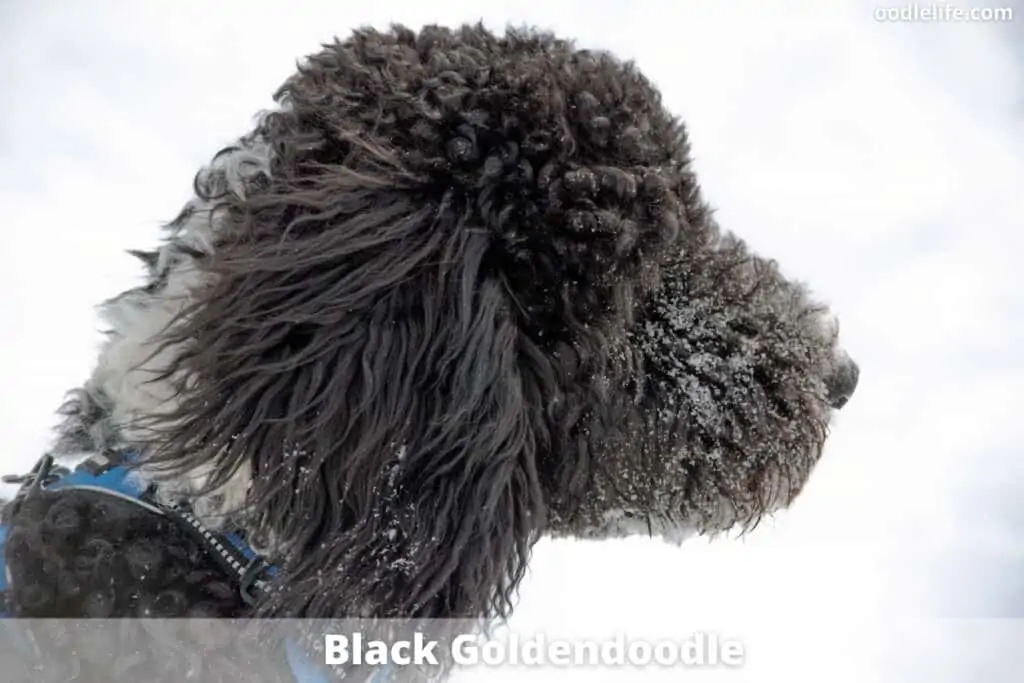15 Types of Goldendoodle Colors (with Photos!)
If you have been planning to bring home a designer dog, one of the top recommendations you may get from pet lovers is the Goldendoodle. Goldendoodles are large dogs with wiry or silky coats, the result of cross-breeding golden retrievers with poodles.
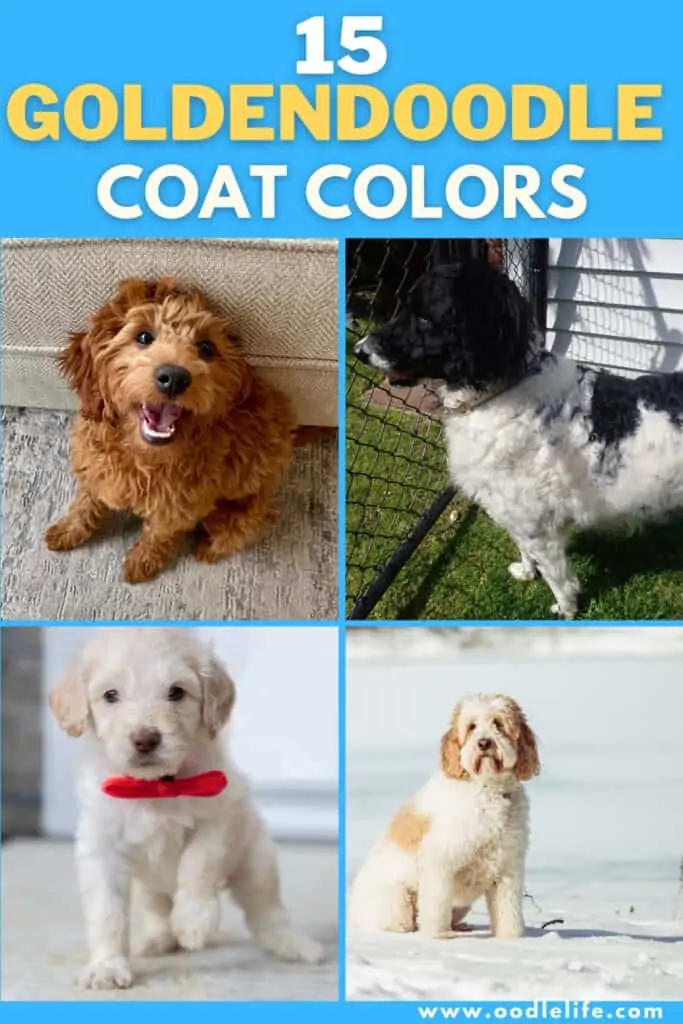
This hybrid dog breed is known to be friendly, gentle, playful, and loving, with a kind and easygoing temperament. Goldendoodles don’t shed much, and some can even be hypoallergenic, making them great pets for people with allergies.
If you’ve been thinking about bringing home a Goldendoodle, there are many details you must consider, one of the most important being its coat color. Contrary to popular belief, Goldendoodles aren’t only yellow; they actually come in various colors!
For decades, dog breeders have experimented with many different gorgeous colors through genetic modifications. The possible colors range from brown or chocolate and apricot to red, cream, champagne, tan, white, black, black and white, gray, silver, and more.
Let’s take a look at the different Goldendoodle coat colors so that you can choose your favorite one.
Standard Goldendoodle Colors
Brown Goldendoodle
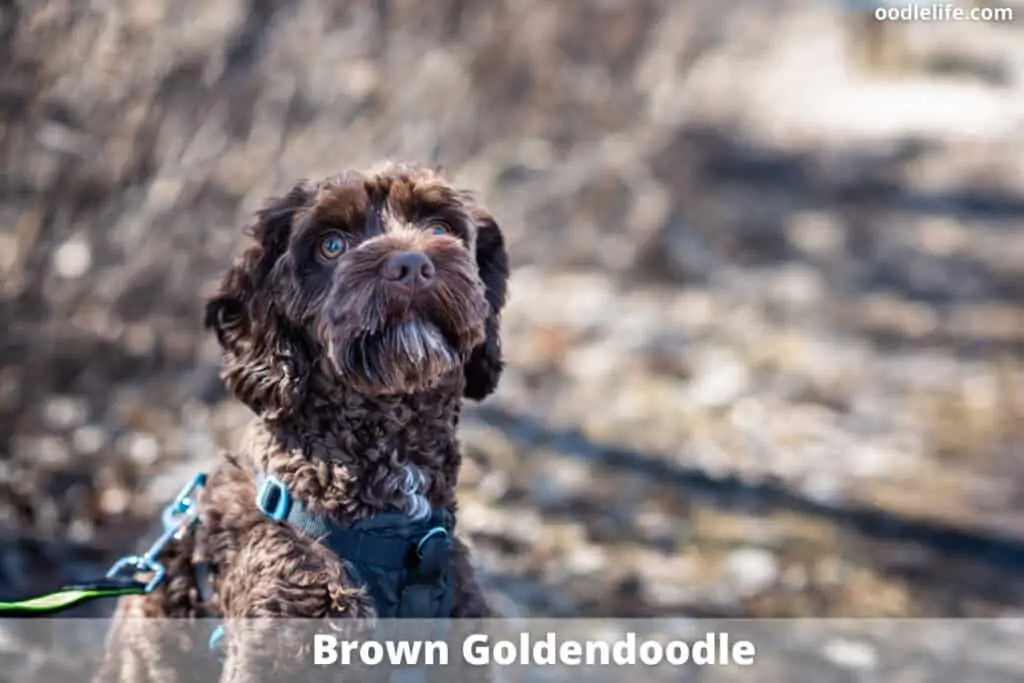
Brown or chocolate is a popular color for Goldendoodles. Brown Goldendoodles typically have a beautiful, deep chocolate color that can appear mahogany to dark walnut. This shade comes from their dominant poodle genes, as the AKC recognizes brown as a standard poodle color.
Note that many brown Goldendoodles experience silvering as they get older. Silvering is a term for the lightening of a dog’s coat color due to age. In the case of brown Goldendoodles, their coats usually lighten to a stately silver or beige.
Despite brown being a standard poodle coat color, breeding two brown Goldendoodles may not give you an all-brown litter. Instead, you may get a mix of multi-colored Goldendoodles in sable (two-toned hairs, the base a light color and the tip black), phantom (two-toned coats with secondary colors above the eyes, on the muzzle, chest, and lower legs), or parti (50% white plus black, chocolate, or red), as the gene that provides brown shades is recessive.
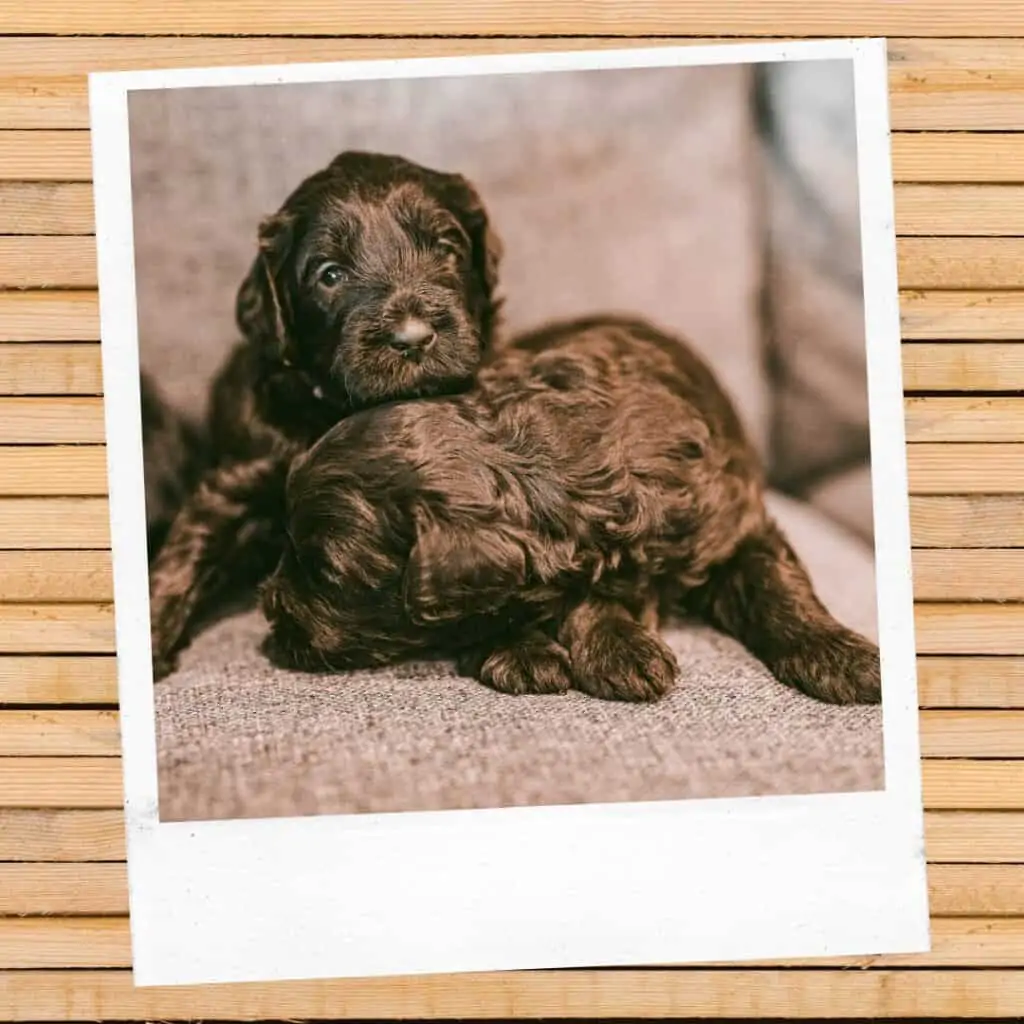
Note that Goldendoodles of this color may suffer from skin diseases and ear infections. So you’ll have to keep a close eye on their overall health and well-being as they age. Fortunately, these conditions are likely to be minor and can easily be treated with medication.
Tan Goldendoodle Color
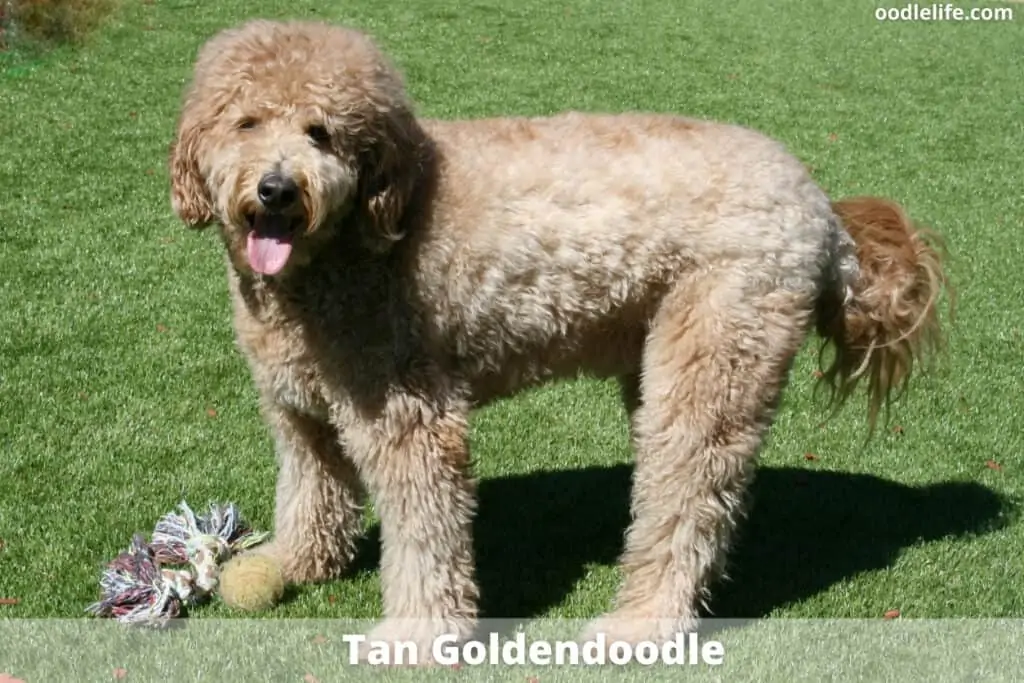
Tan shades can be produced by mixing apricot Goldendoodles with cream ones. So it’s not uncommon to find shades of white and pale apricot in their coats.
Tan Goldendoodles get their unique coloring from their golden retriever genes. The color is quite common and sought after.
Red Coat Goldendoodle
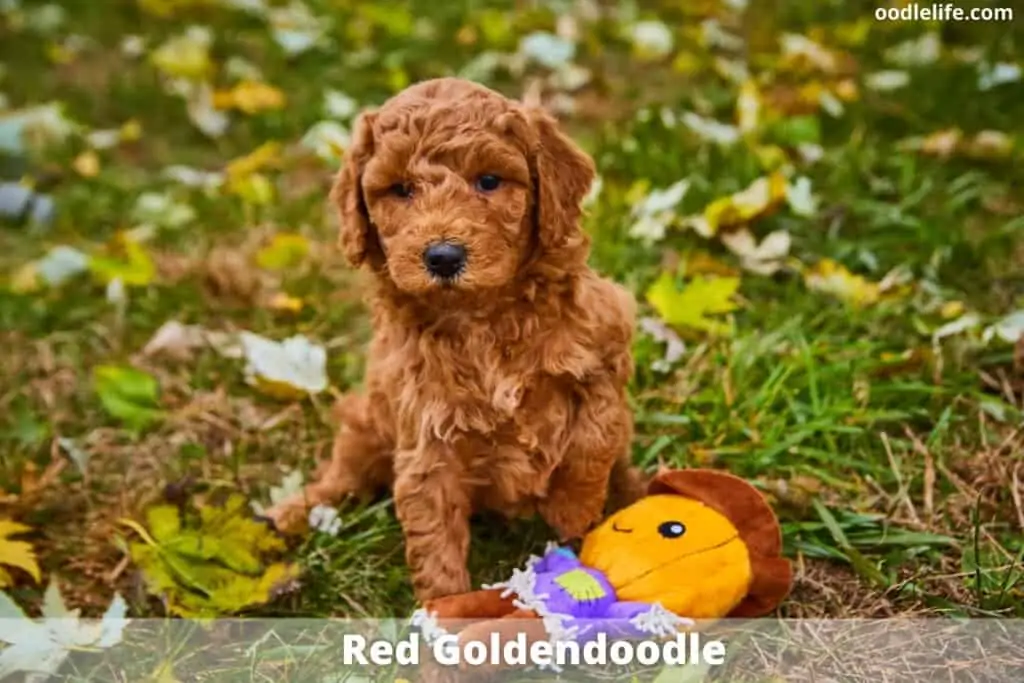
Red is a coveted coat color among Goldendoodles, and it is relatively common. This is because red is also a standard Poodle color officially recognized by the AKC.
This beautiful coloring makes them look like adorable teddy bears, which is a big reason why red Goldendoodles are much sought after by mixed breed enthusiasts. The red color tends to appear as rich mahogany and is deemed the brightest among this breed’s coat colors. The bright red fades to a lighter shade as the dog gets older.
Apricot Coat Color
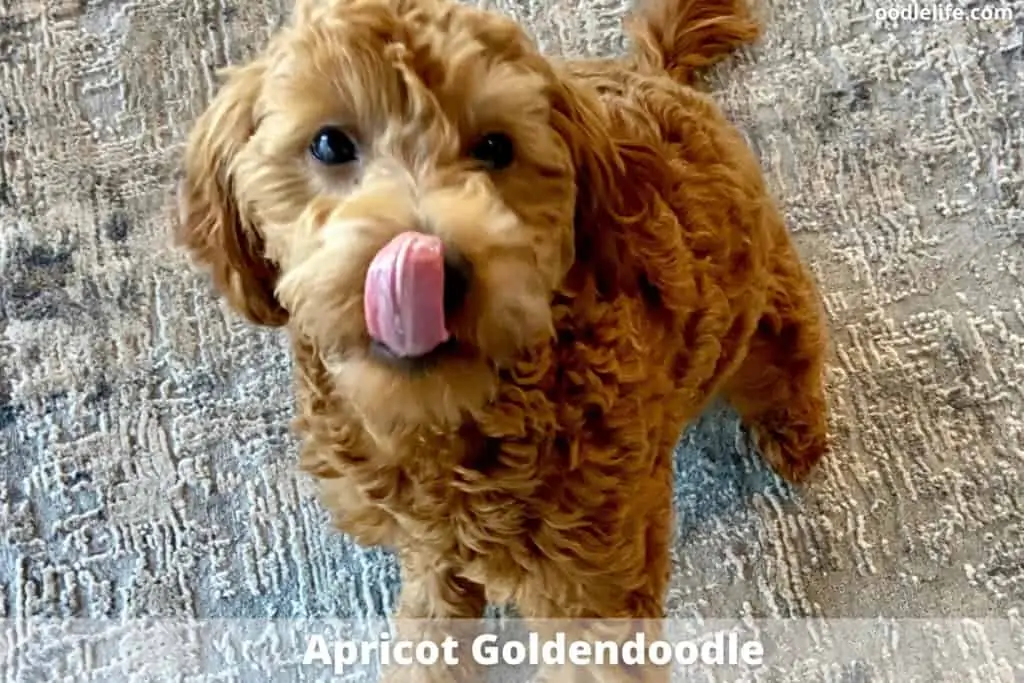
Apricot Goldendoodles are some of the most prized as this unique variation in their coloring makes them resemble cute stuffed animals. Apricot is a standard Poodle color recognized by the AKC, so it’s common to find Goldendoodles in this color.
The apricot Goldendoodle is a variation of its red counterpart. Apricot Goldendoodles have black physical attributes, which include their eyes, eye rims, nose, and nails. Their coat color may also lighten to cream or tan once they age past their puppy years.
Cream Goldendoodle Coat Color
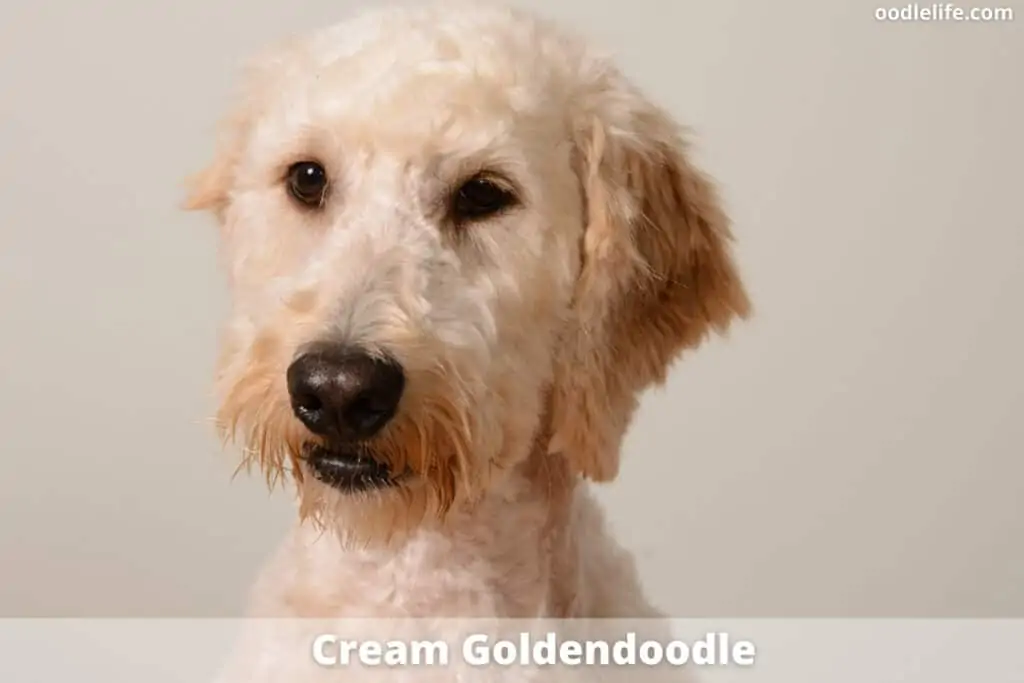
Cream Goldendoodles cannot be accurately described, as you’ll hardly find two of them that are exactly the same in their physical attributes and coat tones. Some cream Goldendoodles may have light brown noses, eyes, and nails, whereas others may have lighter physical makeup. Many of them may have pinkish skin under their coats.
The cream color is another variant of apricot and red Goldendoodles. But the extremely light tint of cream Goldendoodles often leads to confusion with their white counterparts. The AKC only recognizes cream poodles in their breed standard, so the distinction is incredibly important.
Cream-colored Goldendoodles are often bred with each other to create multi-colored pups like parti, phantom, and merle (mottled patches of color, often appearing blue).
White Goldendoodle Coat Color
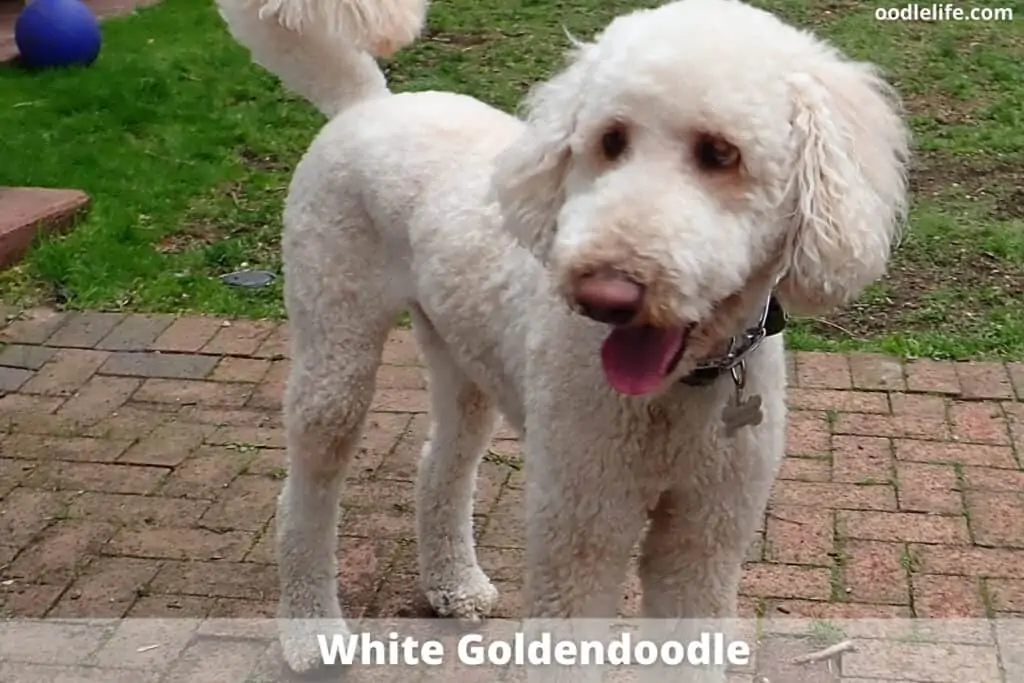
White Goldendoodles are usually not entirely white. They tend to have some cream tints on their coat, making them mostly dual-toned. The white color comes from their Poodle genes.
White Goldendoodles are not commonly bred as they can have poor health compared to other coat colors. They are highly prone to skin diseases, sunburn, indigestion, and stomach upsets. They can also be very hyper.
Black Coat Goldendoodle
Black Goldendoodles are not commonly bred as they don’t have that teddy bear look that makes the breed popular among enthusiasts. Goldendoodles in this color are often confused with purebred black poodles.
Black Goldendoodles usually inherit their color from the standard poodle, and they can be produced only if both their golden retriever and poodle parents carry a recessive black gene.
The coat color usually matches the rest of their body, including the nose, eyes, and paw pads. As they age, the color can turn into silver, gray, or blue.
Rare Goldendoodle Colors
Black and White Goldendoodle
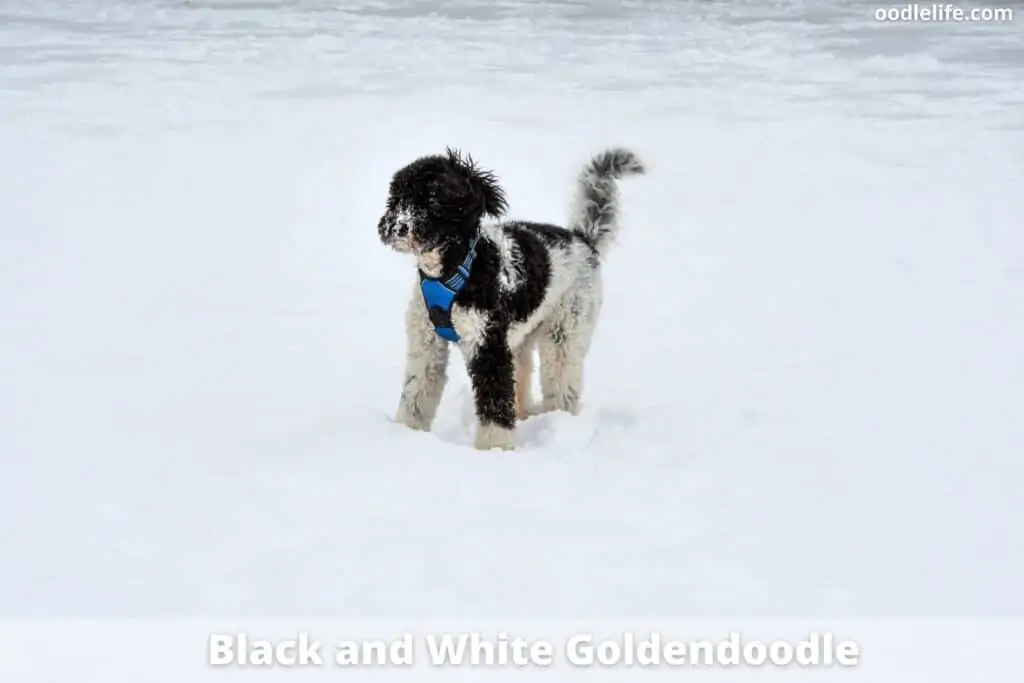
Black and white Goldendoodles are often patterned, with white chests, noses, and white streaks on their heads.
Many black and white Goldendoodles tend to have a tuxedo-like coloring and are hence referred to as Tuxedo Goldendoodles. They have certain coat markings that are different from the standard black and white Goldendoodle, such as a white bib, belly, and hind legs and black coloring on their back and front legs.
Black and white Goldendoodles also come in merle and phantom coat patterns, which we’ll delve into later.
To create a black and white pup, you need to breed a golden retriever with a parti poodle. But even then, you can’t be sure of a black and white litter because of the various genetic mixes.
Like other patterned coats, black and white Goldendoodles are generally found in second-generation and third-generation pups.
Gray
Gray is one of the rarest Goldendoodle colors, along with silver and blue. Gray Goldendoodle pups often have dark, almost black coat colors that transition to gray after about six weeks of age. By the time they are two years old, they develop entirely gray or rustic silver coats.
Gray Goldendoodles are a color variant of the black Goldendoodle and inherit their genes from their poodle lineage. The color is likely derived from multiple generations of breeding.
Silver
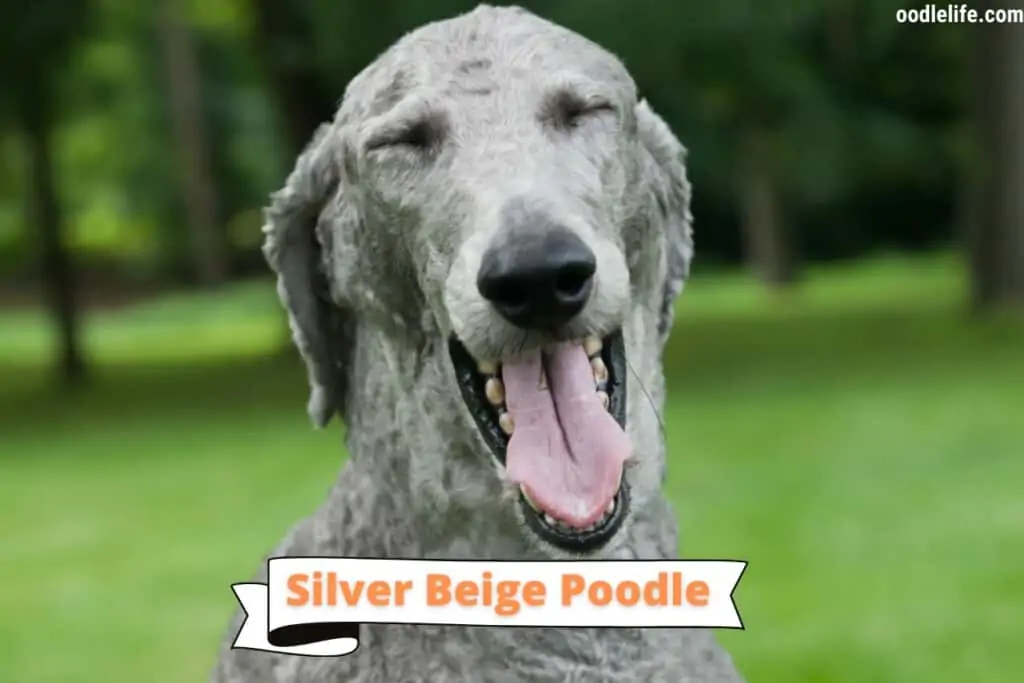
Silver Goldendoodles are often mistaken for their gray or blue counterparts. But they are, in fact, lighter versions of these Goldendoodle colors. Like gray Goldendoodles, silver Goldendoodles are often born with dark fur that lightens to a silver color later on.
You’ll most likely see the first signs of silver when the pups are 6 to 10 weeks old. You may also spot silver or white fur between their toes.
By the age of two, they become completely silver. The precise coat tone tends to differ from dog to dog, but the color is often likened to an old man’s hair.
Silver Goldendoodles are created through multigenerational breeding when the recessive color gene becomes active. This makes the color extremely rare and sought after.
Champagne Goldendoodle Coat
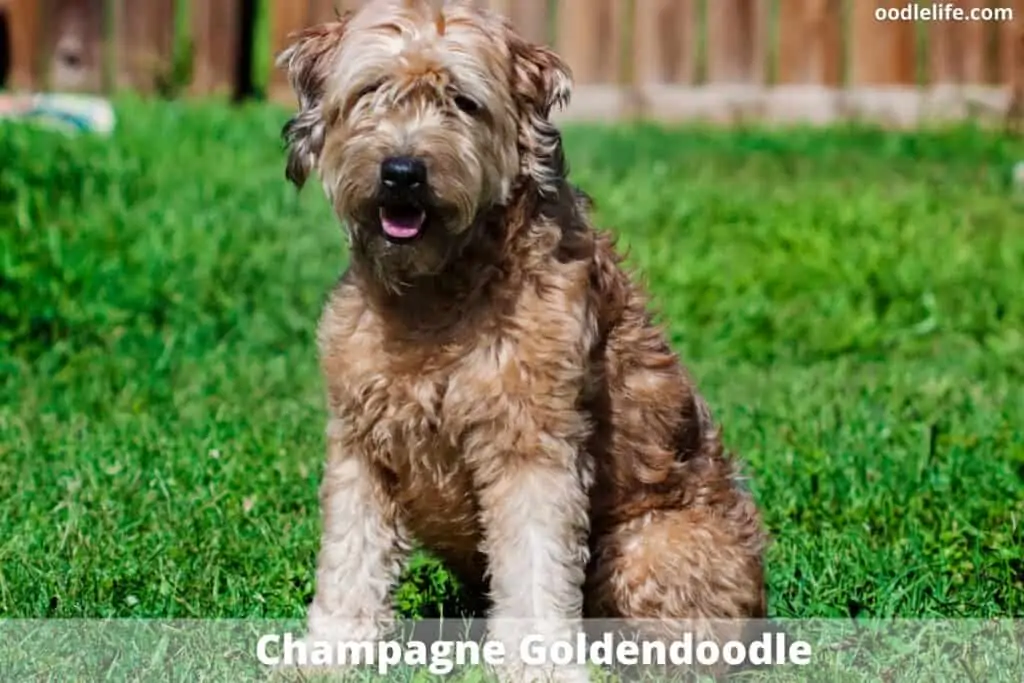
Champagne Goldendoodles are incredibly rare, as their coloring is produced by a recessive red gene that is diluted to create pale yellow or cream coat tones. Their light golden color is quite popular among dog lovers.
A lot of Goldendoodle pups are also born with a darker golden coat color that lightens to a champagne coat as they age.
Phantom
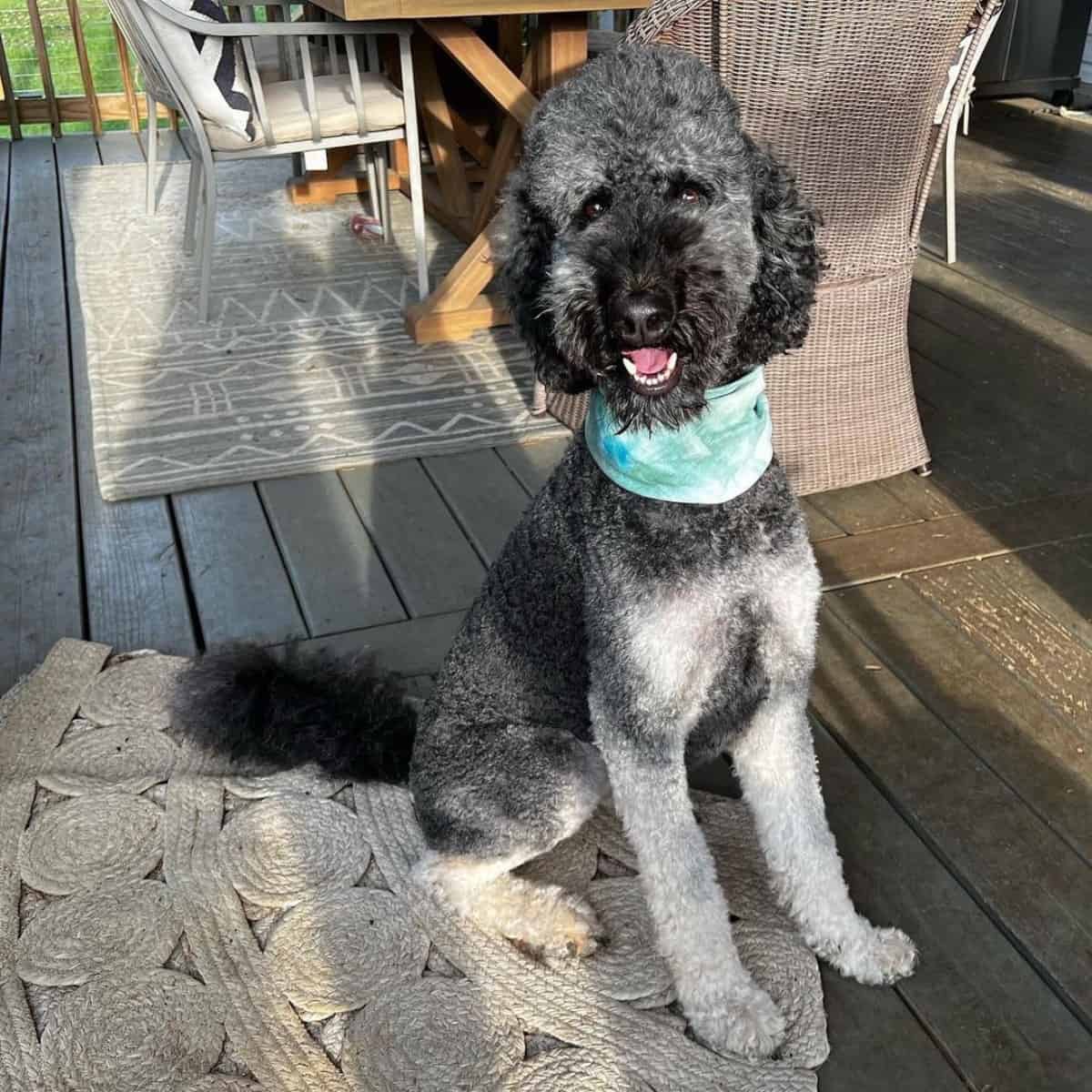
Phantom Goldendoodles have two colors in their coats. The first color is the base shade that covers most of the dog’s body. The secondary color is a lighter tone that colors its muzzle, eyes, and the lower portion of its legs. The base is usually chocolate brown or black.
A phantom Goldendoodle is often colored black with tan markings. But you can sometimes find a mix of red, brown, black, and silver, too. This range of colors makes each phantom Goldendoodle different from another.
It is easy to spot a phantom Goldendoodle early on, as it has its unique markings from birth and doesn’t lose them with age. The phantom pattern is rare among Goldendoodles because it is caused by a recessive gene that can’t be found in first-generation pups. Both parents of a phantom Goldendoodle need to carry the gene to pass it on to their litters.
Sable
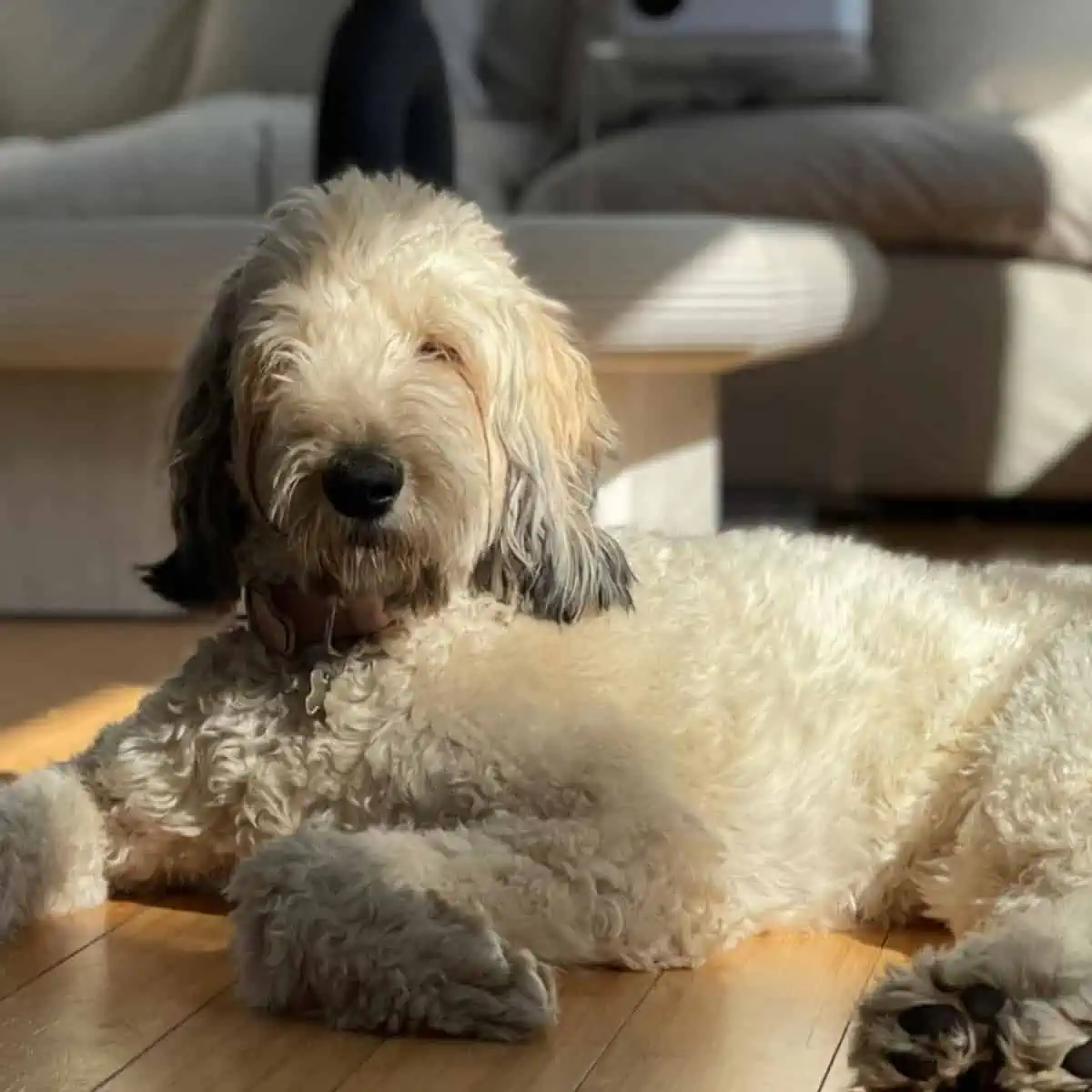
Sable Goldendoodles are one of the rarest, most coveted, and also most interesting pups as their colors keep changing over time due to a recessive gene. They are usually born in a solid black or chocolate brown coat color that begins to fade with age to a lighter cream or tan color with black or brown tips.
The base is often tan and cream. Sable Goldendoodles tend to retain their original dark coloring on the face and ears, making them dual-toned.
Parti Goldendoodle
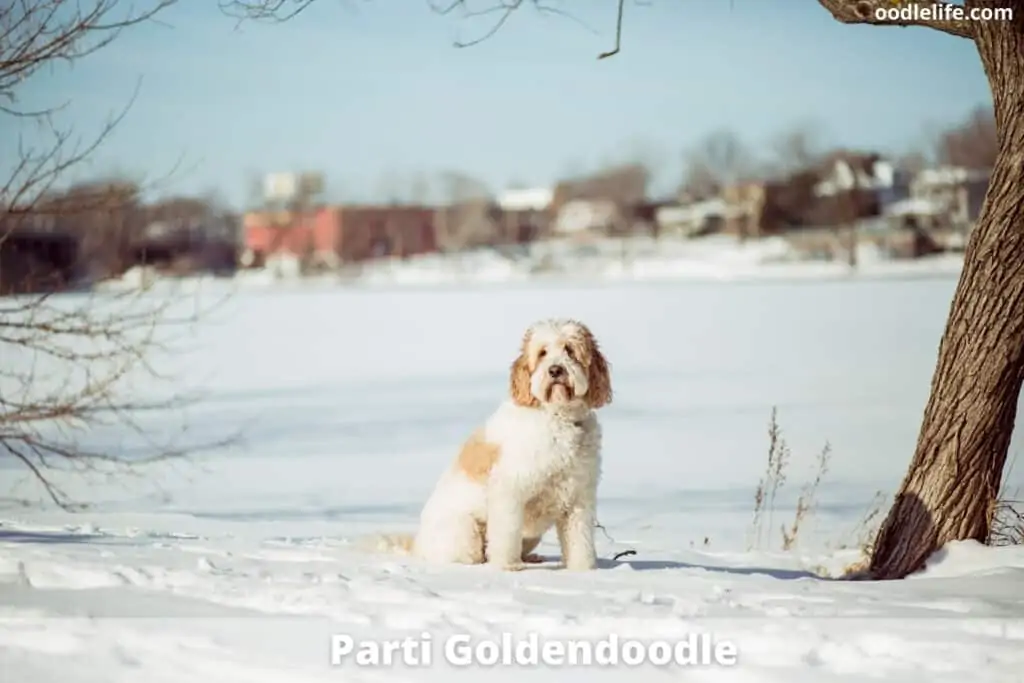
Parti Goldendoodles have bi-colored coats, one of which must be at least 50% white. Their secondary color can be any solid shade, but the most common ones are apricot and tan.
Parti Goldendoodles are produced by breeding rare recessive genes that override the solid shade. So these dogs are usually seen in later generations of Goldendoodles, which makes them extremely rare and difficult to cultivate.
Merle
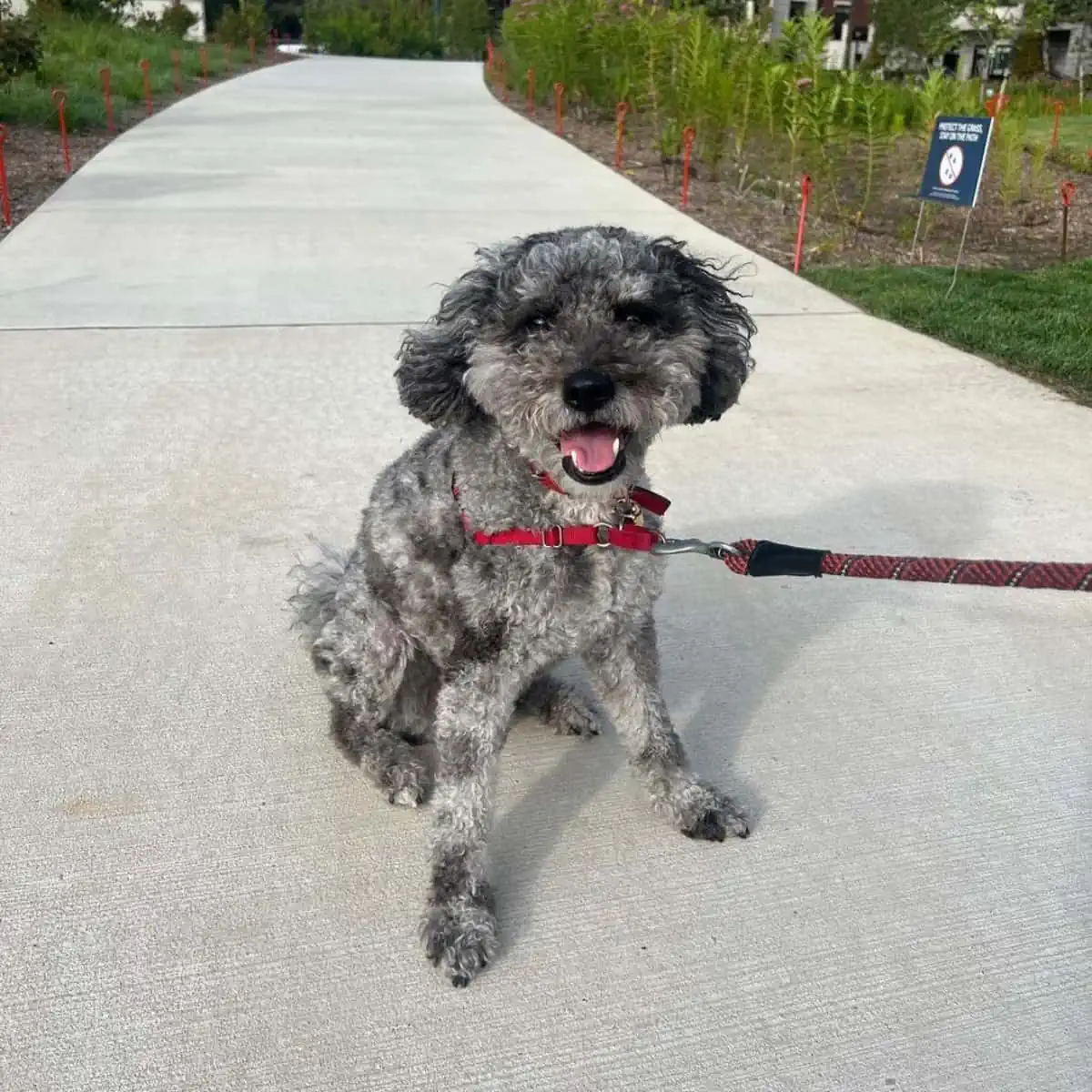
Merle Goldendoodles have mottled color patches on their coat in two base colors: red and black. They come in “classic” and the rarer “watercolor” variants.
Classic merle Goldendoodles have blue or brown patches or tickings on their coat. Watercolor merles have tickings, too, but their primary shade lightens as they age.
Merle Goldendoodles can be produced by cross-breeding a poodle with an Australian shepherd or a border collie. This makes them Aussiedoodles or Bordoodles instead of Goldendoodles.
You may also get a merle-patterned Goldendoodle from multigenerational breeding of Goldendoodles. However, this practice should be avoided as these pups are susceptible to serious conditions, such as blindness, deafness, skin cancer, skin allergies, and other illnesses.
This is because of the dominant genes of a merle Goldendoodle that override a solid-colored Goldendoodle. At least one of a merle Goldendoodle’s parents needs to be merle-colored and mask the recessive genes.
Merle Goldendoodles need to be bred carefully by a breeder with good knowledge about canine genetics to prevent serious deformities. For this reason, merle Goldendoodles can be significantly more expensive than other color variants.
Why Are There So Many Different Goldendoodle Colors?
The American Kennel Club (AKC) officially recognizes three standard golden retriever coat colors: golden, dark golden, and light golden. Poodles come in eleven standard AKC-recognized colors: apricot, black, blue, red, brown, gray, silver, silver beige, white, cream, and cafe au lait.
Both breeds also come in rare colors, and poodles come in parti colors, too. Cross-breeding creates a wide range of possible colors that mixed breed enthusiasts can choose from.
Given the complexity of mixed genetics, rare colors can be created by breeding generational crosses. For example, breeding two F1 Goldendoodles (50% purebred golden retriever and 50% purebred poodle) will lead to F2 pups that can have unpredictable coat colors (cream, brown, red) and hair types (curly poodle hair or wavy retriever fur).
There are endless possibilities when it comes to these physical characteristics. If you want a Goldendoodle in a specific rare color, it’s best to find a well-regarded, licensed, ethical mixed breeder in your area to ensure its health and well-being throughout its life.
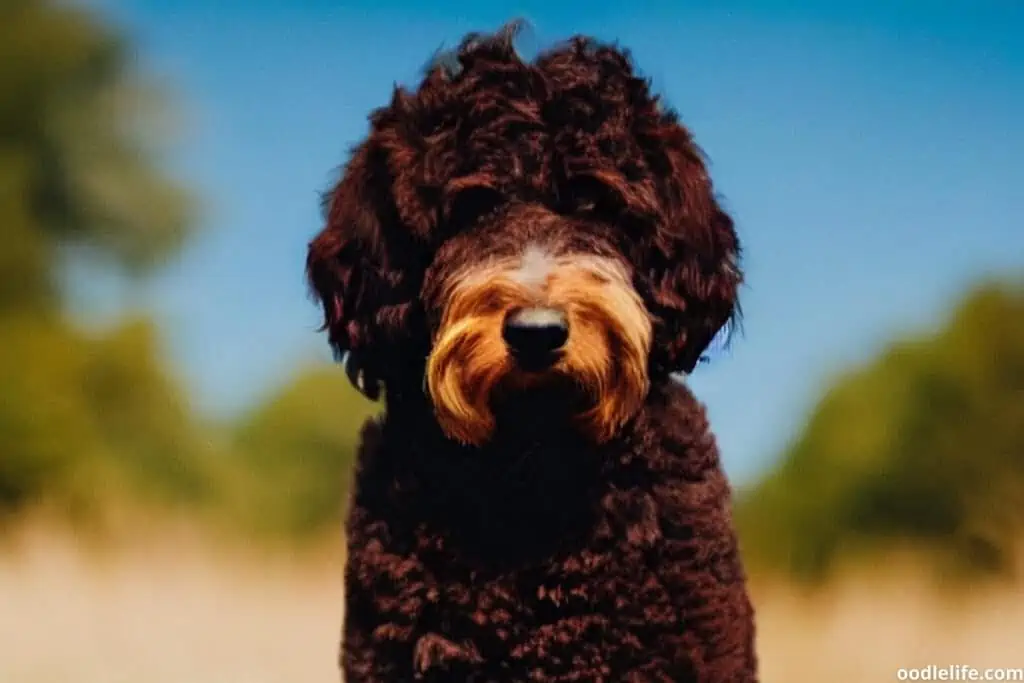
Final Thoughts
We hope our Goldendoodle color guide has given you all the information you need to get a pup in your favorite color. But more than color, it’s best if you consider factors like the breeder’s reliability and the pup’s health before bringing one home.
If you would like to ask any questions about Goldendoodle coat colors or share your thoughts about them, please do so in the comments section below! We’d love to hear from you.
